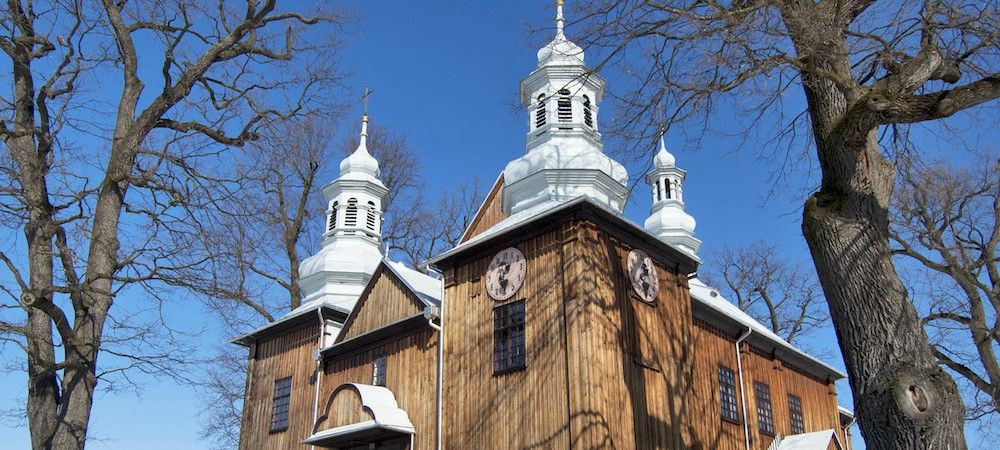
Jasienica Rosielna
The village of Jasienica Rosielna, whose name is widely recognised thanks to the dairy cooperative, was once a town. It is also known for its sweeping manor park and the beautiful church – the grandest example of wooden Baroque architecture in the region.
In the Middle Ages, Jasienica was part of lands belonging to the Kamieniec Castle and owned, among others, by the Kamienieckis, the Boners, and the Firlejs. Since 1687, the local land was owned by Stainisław Wierzbicki, who decided to make Jasienica a town and in 1727 obtained for the village the right to organise fairs and markets. Unfortunately, he did not finish his project as after the sudden death of his wife and children he forsook earthly life and entered the Church. He left his property to his sister Ludwika, married to Hieronim Załuski, and it was only their son Ignacy who obtained town privileges for Jasienica – he had managed it by 1764.
The town was established relatively late and it is difficult to see signs of urban planning in its layout today. However, the magnificent Baroque parish church of Our Lady of the Immaculate Conception funded by Ignacy and his wife Marianna in 1770 is a clear proof of the Załuskis’ ambition.
The church is a rare example of a wooden building with a richly decorated façade typical for Baroque. The façade is formed by two towers and the lower vestibule between them, topped with a triangular gable. The towers have bulbous domes characteristic of Baroque style. On the south tower, there is a mechanical clock made by a blacksmith from the nearby village of Orzechówka, as the Mięsowicz’s factory in Krosno had not been opened yet.
When you enter the church, the impression of seeing a unique building is even clearer. The church is exceptionally consistent in style and catches the spirit of Baroque perfectly – all the elements of the interior come from the time the church was built and, as the sponsors were rather generous, the black-gold-silver whole will not leave even those most resistant to art indifferent.
There are paintings of the founders of the church inside, as well as plaques commemorating the members of the Załuski family. If you are interested in seeing more portraits of this family, who have done much for the region, visit the Sanok Castle, where they are a pride of the gentry portraits gallery.
In 1881, Jasienica passed to Stanisław Wysocki when he married Zofia Załuska. The couple built themselves a new residence, inspired by the architecture of the contemporary health resorts. Unfortunately, it was destroyed by a fire in February of 1917 and is commemorated today by a lonely columned portico. Seventy years later, a building of the District Culture Centre was constructed next to it.
Zofia and Stanisław’s son, also Stanisław, was the last owner of the Jasienica estate. He was not a typical landowner of his time, as in 1927 he co-founded the dairy cooperative that exists to this day and makes the name Jasienica Rosielna recognisable.
Nature lovers will be interested to learn that the sweeping English landscape park (14 ha) from the times of the Załuski family, established in the 18th century, has survived too. It is one of the most interesting parks in the region. Among its several hundred trees, there are a few monuments of nature, notably a majestic, over three hundred years old white pine.
fot.: arch. Arete sp. z o.o.
The town was established relatively late and it is difficult to see signs of urban planning in its layout today. However, the magnificent Baroque parish church of Our Lady of the Immaculate Conception funded by Ignacy and his wife Marianna in 1770 is a clear proof of the Załuskis’ ambition.
The church is a rare example of a wooden building with a richly decorated façade typical for Baroque. The façade is formed by two towers and the lower vestibule between them, topped with a triangular gable. The towers have bulbous domes characteristic of Baroque style. On the south tower, there is a mechanical clock made by a blacksmith from the nearby village of Orzechówka, as the Mięsowicz’s factory in Krosno had not been opened yet.
When you enter the church, the impression of seeing a unique building is even clearer. The church is exceptionally consistent in style and catches the spirit of Baroque perfectly – all the elements of the interior come from the time the church was built and, as the sponsors were rather generous, the black-gold-silver whole will not leave even those most resistant to art indifferent.
There are paintings of the founders of the church inside, as well as plaques commemorating the members of the Załuski family. If you are interested in seeing more portraits of this family, who have done much for the region, visit the Sanok Castle, where they are a pride of the gentry portraits gallery.
In 1881, Jasienica passed to Stanisław Wysocki when he married Zofia Załuska. The couple built themselves a new residence, inspired by the architecture of the contemporary health resorts. Unfortunately, it was destroyed by a fire in February of 1917 and is commemorated today by a lonely columned portico. Seventy years later, a building of the District Culture Centre was constructed next to it.
Zofia and Stanisław’s son, also Stanisław, was the last owner of the Jasienica estate. He was not a typical landowner of his time, as in 1927 he co-founded the dairy cooperative that exists to this day and makes the name Jasienica Rosielna recognisable.
Nature lovers will be interested to learn that the sweeping English landscape park (14 ha) from the times of the Załuski family, established in the 18th century, has survived too. It is one of the most interesting parks in the region. Among its several hundred trees, there are a few monuments of nature, notably a majestic, over three hundred years old white pine.
fot.: arch. Arete sp. z o.o.
